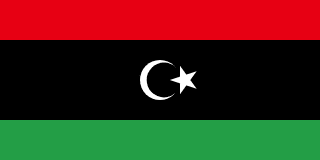Libya - Geography

Here, let us take a look at the Geography of Libya. note 1: more than 90% of the country is desert or semidesert
note 2: the volcano Waw an Namus lies in south central Libya in the middle of the Sahara; the caldera is an oasis -- the name means "oasis of mosquitoes" -- containing several small lakes that host many species of insects and birds. Mother's mean age at first birth is (), whereas, the Maternal mortality ratio is 59 deaths/100,000 live births (2023 est.)
Geographical data of Libya
| Location | Northern Africa, bordering the Mediterranean Sea, between Egypt, Tunisia, and Algeria |
|---|---|
| Geographic coordinates | 25 00 N, 17 00 E |
| Map references | Africa |
| Tarrain | mostly barren, flat to undulating plains, plateaus, depressions |
| Natural Resources | petroleum, natural gas, gypsum |
| Natural Hazards | hot, dry, dust-laden ghibli is a southern wind lasting one to four days in spring and fall; dust storms, sandstorms |
| Irrigated Land | 4,700 sq km (2012) |
| Major rivers (by length in km) | |
| Major aquifers | Nubian Aquifer System, North Western Sahara Aquifer System, Murzuk-Djado Basin |
| Land Boundaries | 4,339 km |
| Border Countries | Algeria 989 km; Chad 1,050 km; Egypt 1,115 km; Niger 342 km; Sudan 382 km; Tunisia 461 km |
| Coastline | 1,770 km |
| Climate | Mediterranean along coast; dry, extreme desert interior |
| Area | |
| Total Area | |
| Land Area | 1,759,540 sq km |
| Water Area | 0 sq km |
| comparative Area | about 2.5 times the size of Texas; slightly larger than Alaska |
| Maritime Claims | |
| Territorial sea | 12 nm |
| Exclusive fishing zone | 62 nm |
| Elevations | |
| Highest point | Bikku Bitti 2,267 m |
| Lowest point | Sabkhat Ghuzayyil -47 m |
| Mean elevation | 423 m |
| Land Use | |
| Agricultural land | 8.7% (2023 est.) |
| Agricultural land: arable land | arable land: 1% (2023 est.) |
| Agricultural land: permanent crops | permanent crops: 0.2% (2023 est.) |
| Agricultural land: permanent pasture | permanent pasture: 7.6% (2023 est.) |
| Forest | 0.1% (2023 est.) |
| Other | 91.2% (2023 est.) |
Population Distribution
Over 90% of the population lives along the Mediterranean coast in and between Tripoli to the west and Al Bayda to the east; the interior remains vastly underpopulated due to the Sahara and its lack of surface water, as shown in this population distribution map
People and Society
In Libya, the different Ethnic groups are such that we have: Amazigh and Arab 97%, other 3% (includes Egyptian, Greek, Indian, Italian, Maltese, Pakistani, Tunisian, and Turkish)
| Population | |
|---|---|
| Pop growth rate | 1.44% (2024 est.) |
| Birth rate | 20.3 births/1,000 population (2024 est.) |
| Death rate | 3.5 deaths/1,000 population (2024 est.) |
| Health expenditure | |
| Physicians Density | |
| Hospital bed Density | 3.2 beds/1,000 population (2021 est.) |
| Total fertility rate | 3 children born/woman (2024 est.) |
| Gross reproduction rate | 1.46 (2024 est.) |
| Contraceptive prevalence rate | |
| Est married women (ages 15-49) | 59.2% (2023 est.) |
| Literacy | |
| Education expenditures | |
| Net Migration rate | -2.5 migrant(s)/1,000 population (2024 est.) |
| Nationality | Libyan | Libyan(s) |
| Languages | |
| Religions | Muslim (official; virtually all Sunni) 96.6%, Christian 2.7%, Buddhist <1%, Hindu <1%, Jewish <1%, folk religion <1%, other <1%, unaffiliated <1% (2020 est.) |
| Age Structure | |
| 0-14 years | 32.3% (male 1,211,087/female 1,165,648) |
| 15-64 years | 63.2% (male 2,385,152/female 2,263,780) |
| 65 years and over | 4.6% (2024 est.) (male 151,125/female 184,471) |
| Dependency Ratios | |
| Total dependency ratio | 58.3 (2024 est.) |
| Youth dependency ratio | 51.1 (2024 est.) |
| Elderly dependency ratio | 7.2 (2024 est.) |
| Potential support ratio | 13.9 (2024 est.) |
| Median Age | |
| Total | 26.2 years (2024 est.) |
| Male | 26.3 years |
| Female | 26.2 years |
| Urbanization | |
| Urban population | 81.6% of total population (2023) |
| Rate of urbanization | 1.45% annual rate of change (2020-25 est.) |
| Major urban areas (Pop) | 1.183 million TRIPOLI (capital), 984,000 Misratah, 859,000 Benghazi (2023). |
| Sex Ratio | |
| At birth | 1.05 male(s)/female |
| 0-14 years | 1.04 male(s)/female |
| 15-64 years | 1.05 male(s)/female |
| 65 years and over | 0.82 male(s)/female |
| Total population | 1.04 male(s)/female (2024 est.) |
| Infant Motality | |
| Total | 10.7 deaths/1,000 live births (2024 est.) |
| Male | 12.1 deaths/1,000 live births |
| Female | 9.3 deaths/1,000 live births |
| Life Expectancy at birth | |
| Total population | 77.7 years (2024 est.) |
| Male | 75.5 years |
| Female | 80 years |
| Drinking Water Sources | |
| Improved: total | total: 99.9% of population (2022 est.) |
| Unimproved: total | total: 0.1% of population (2022 est.) |
| Sanitation facility acess | |
| Improved: total | total: 99.3% of population (2022 est.) |
| Unimproved: total | total: 0.7% of population (2022 est.) |
| Alcohol consumption per capita | |
| Total | 0.01 liters of pure alcohol (2019 est.) |
| Beer | 0 liters of pure alcohol (2019 est.) |
| Wine | 0.01 liters of pure alcohol (2019 est.) |
| Spirits | 0 liters of pure alcohol (2019 est.) |
| Other alcohols | 0 liters of pure alcohol (2019 est.) |
Demographic profile
All Important Facts about Libya
Want to know more about Libya? Check all different factbooks for Libya below.









